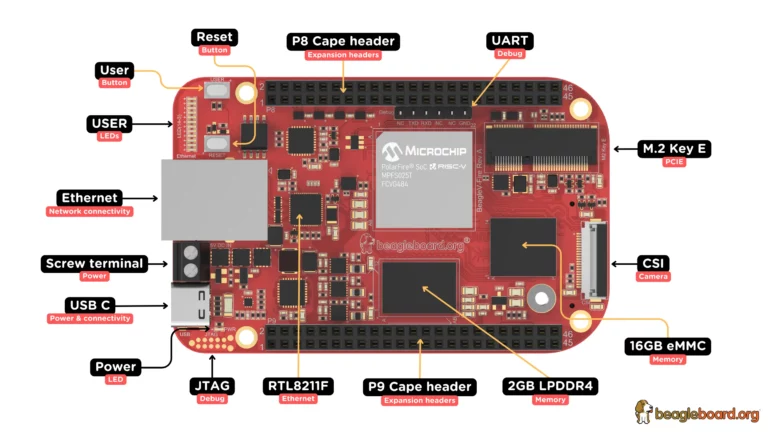BeagleV®-Fire
Overview
BeagleV®-Fire is a revolutionary single-board computer (SBC) powered by the Microchip’s PolarFire® MPFS025T 5x core RISC-V System on Chip (SoC) with FPGA fabric. BeagleV®-Fire opens up new horizons for developers, tinkerers, and the open-source community to explore the vast potential of RISC-V architecture and FPGA technology. It has the same P8 & P9 cape header pins as BeagleBone Black allowing you to stack your favorite BeagleBone cape on top to expand it’s capability. Built around the powerful and energy-efficient RISC-V instruction set architecture (ISA) along with its versatile FPGA fabric, BeagleV®-Fire SBC offers unparalleled opportunities for developers, hobbyists, and researchers to explore and experiment with RISC-V technology.

Building
Applications for the beaglev_fire board configuration can be built as usual:
# From the root of the zephyr repository
west build -b beaglev_fire samples/hello_world
Debugging
In order to upload the application to the device, you’ll need OpenOCD and GDB with RISC-V support. You can get them as a part of SoftConsole SDK. Download and installation instructions can be found on Microchip’s SoftConsole website.
You will also require a Debugger such as Microchip’s FlashPro5/6.
Connect to BeagleV-Fire UART debug port using a 3.3v USB to UART bridge.
Now you can run tio <port> in a terminal window to access the UART debug port connection. Once you
are connected properly you can press the Reset button which will show you a progress bar like:

Once you see that progress bar on your screen you can start pressing any button (0-9/a-z) which will interrupt the Hart Software Services from booting its payload.
With the necessary tools installed, you can connect to the board using OpenOCD. from a different terminal, run:
<softconsole_path>/openocd/bin/openocd --file \
<softconsole_path>/openocd/share/openocd/scripts/board/microsemi-riscv.cfg
Leave it running, and in a different terminal, use GDB to upload the binary to the board. You can use the RISC-V GDB from the Zephyr SDK. launch GDB:
<path_to_zephyr_sdk>/riscv64-zephyr-elf/bin/riscv64-zephyr-elf-gdb
Here is the GDB terminal command to connect to the device and load the binary:
set arch riscv:rv64
set mem inaccessible-by-default off
file <path_to_zehyr.elf>
target extended-remote localhost:3333
load
break main
continue